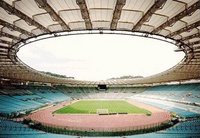
One of the less-remarked upon results of last week's internationals was also one of the saddest: Malta 2 - Hungary 1. The result came almost exactly 50 years after the Soviet invasion of Hungary in 1956, which occurred at a time when the Hungarians were the most feared team in Europe.
As Nick Hornby says, it's a long way down.
Hungarian success in the 1950s was partly built around an astonishing generation of talented players (Hidegkuti, Kocsis, Czibor and of course, the pictured Ferenc Puskas), but also around a trio of strong coaches (Guttman, Sebes and Bukovi) - who together probably had more influence on the tacitcal side of the modern game than anyone sense (Rinus Michels possibly excepted).
The Hungarians were the first to play a 4-2-4, with a deep-lying, play-making midfielder (effectively the position Riquelme now plays), a goalkeeper acting as a sweeper, kamikaze wingers and constant movement off the ball. It was an outrageously attacking formation - and one which in 1953 allowed the Hungarians to totally flummoxed the English national team (which then, even more than now, beleived itself to be the best in the world), in a pair of 6-3 and 7-1 friendly victories. Though it was Brazil which was to perfect this formation at the 1958 World Cup by tightening up the defence, it was an authentically Hungarian invention. Between 1952 and 1956, the national side having lost only once - sadly, in the final of the 1954 World Cup. But even the German triumph in Berne did not seriously dent the lustre of the Magyar side. They were, simply, the best side of the 1950s.
In late October 1956, when the trouble started in Budapest, the Hungarian national team were getting ready for a game against Sweden at their training camp in Tata, about 45 miles north of the capital. The chaos of the initial fighting in Budapest led to the cancellation of the Swedish game and the dispersal of the players back to their home teams. The two biggest teams of the time - secret police side MTK (home of Hidegkuti) and army side Honved (home to Puskas, Kocsis and Czibor) - used the brief lull in fighting at the end of October to arrange "friendly tours" in Europe and South America. Both these teams, plus the under-21 side, wich was playing a qualifying match in Belgium, were thus out of the country when the Soviets invaded in early November.
(For anyone confused as to why Ferencvaros was not considered a "big side", its pre-war right-wing connections - enthusiastically re-embraced since 1989 - meant it got very little favourable treatment under the communists, and constantly saw its good youth players dispatched to other sides).
The friendly tours lasted until late January as the players tried to wait out the instability at home. Eventually, they had to make decisions about whether to return. Many - incuding Hidegkuti - did so. Others - including the entire under-21 team - chose to stay in the west. Puskas ended up at Real Madrid, where he spent many years combining with Alfredo di Stefano to make the
los merengues the most feared team in Europe; Kocsis and Czibor went to Barcelona. (Why did they all end up in Spain? Because England and Italy frowned on foreigners at the time, and it was a big propaganda coup for Franco to have refugees from communism playing in La Liga).
The defections devastated the national team. The 1958 squad crashed out of the World cup in the first round, but a mini-revival allowed the team made the quarter finals in '62 and '66. The team failed to qualify for the next two cups, but managed to make it as far as the first round in Argentina, Spain and Mexico. Since 1986, however their record has been nothing short of disastrous and their last World Cup win is now over 20 years old, a 2-0 victory over Canada in Irapuato.
Today, football in Hungary is very sad. Crowds which once flocked to see the great lights of the Golden Team have dwindled to just a couple of thousand per game. Racist skinheads are a major part of the remaining crowds. Money is scarce, there is no money for development and the stadia are in dire need of upgrades. As Johnathan Wilson recounts in his excellent new
book, when someone tried to call in a bomb threat to the Dunakesi club in 1999, they had to leave a message with the factory next door as the club's own phone had been disconnected. Even the great Ferencvaros - who won the league as recently as 2004 - have been demoted to the second division for financial irregularities.
Eastern Europe - Russia and Romania in particular - seem to be recovering the footballing prestige they lost in the 1990s. It is a resurgance which, sadly, seems set to pass Hungary by completely.










